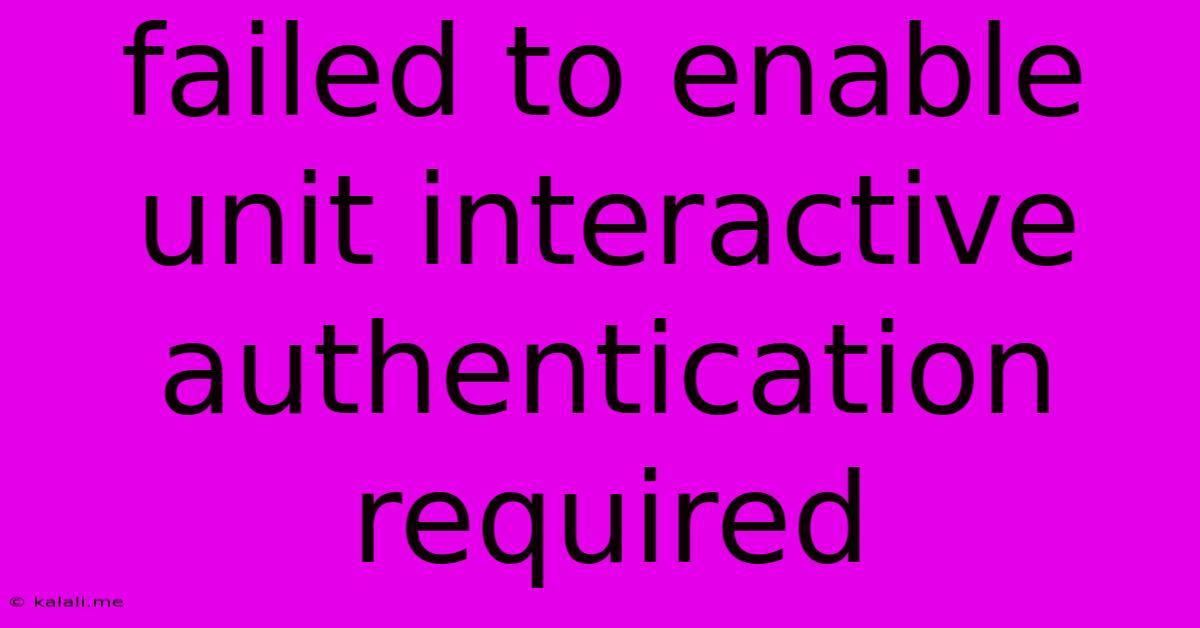Failed To Enable Unit Interactive Authentication Required
Kalali
May 31, 2025 · 4 min read

Table of Contents
Failed to Enable Unit Interactive Authentication Required: Troubleshooting Guide
This error message, "Failed to enable unit interactive authentication required," typically arises during the configuration or use of authentication systems, often within virtual environments or containerized applications. It signals a problem with the authentication process, preventing the system from properly verifying user credentials or establishing a secure connection. This guide will delve into common causes and provide effective troubleshooting steps. Understanding the underlying cause is crucial for a successful resolution.
Understanding the Error
The error message implies a failure to properly integrate an authentication mechanism that demands user interaction. This interactive authentication, often involving a username and password, is vital for security. The "unit" mentioned may refer to a specific service, application, or virtual machine requiring authentication. The failure could stem from various factors, ranging from misconfiguration to network connectivity issues.
Common Causes and Troubleshooting Steps
Several factors can contribute to this frustrating error. Let's break down the most frequent causes and the steps you can take to resolve them:
1. Incorrect Credentials:
- Problem: This is the most common reason. The username or password used for authentication might be wrong, outdated, or typed incorrectly.
- Solution: Double-check your credentials meticulously. Ensure you're using the correct username and password for the specific system or application generating the error. Reset your password if necessary, following the prescribed procedures for your system.
2. Network Connectivity Issues:
- Problem: The system might be unable to reach the authentication server due to network problems like a firewall blocking the connection, a faulty network cable, or DNS resolution failures.
- Solution: Verify your network connectivity. Check your internet connection. Ensure your firewall isn't blocking communication with the authentication server (often on port 443 for HTTPS). Try pinging the authentication server's IP address to test connectivity.
3. Configuration Errors:
- Problem: The authentication configuration files might contain errors, incorrect settings, or missing components. This is particularly relevant in virtual environments or containerized setups.
- Solution: Examine the configuration files related to the authentication system. Look for syntax errors, incorrect paths, missing parameters, or inconsistencies with other system settings. Correct any errors and ensure that the configuration is valid. Carefully review the documentation for your specific authentication system.
4. Authentication Service Issues:
- Problem: The authentication service itself might be down, malfunctioning, or experiencing temporary outages.
- Solution: Check the status of the authentication service. If it's a cloud-based service, check their status page for any reported outages or maintenance activities. If it's a local service, restart the service or the entire system. Consult system logs for any error messages that might provide further clues.
5. Permissions Problems:
- Problem: The user account might lack the necessary permissions to access the required resources or perform the authentication.
- Solution: Verify the user's permissions. Ensure the account has the appropriate access rights for the system or application in question. If necessary, consult your system administrator to adjust permissions.
6. Outdated Software or Drivers:
- Problem: Outdated authentication libraries or drivers can lead to compatibility issues and authentication failures.
- Solution: Update all relevant software and drivers to their latest versions. This includes the authentication software, operating system, and any necessary network drivers.
7. Software Conflicts:
- Problem: Conflicting software or applications might interfere with the authentication process.
- Solution: Temporarily disable any non-essential software or applications to see if this resolves the issue. If you identify a conflict, you may need to investigate compatibility issues or uninstall the problematic software.
Advanced Troubleshooting Steps
If the basic troubleshooting steps don't resolve the issue, consider these more advanced options:
- Check System Logs: Analyze system logs for any error messages related to authentication. These logs might contain specific error codes or details that can help pinpoint the problem's root cause.
- Consult Documentation: Refer to the official documentation for your specific authentication system, application, or virtual environment for detailed troubleshooting instructions and advanced configuration options.
- Seek Expert Assistance: If you are unable to resolve the issue after trying these steps, seeking assistance from a qualified IT professional or system administrator might be necessary.
By systematically addressing these potential issues, you should be able to resolve the "Failed to enable unit interactive authentication required" error and restore proper authentication functionality. Remember to always prioritize security best practices when managing authentication systems.
Latest Posts
Latest Posts
-
How To Identify River Rocks With Fossilas
Jun 01, 2025
-
What You Got On My 40
Jun 01, 2025
-
How Do You Get Diesel Fuel Out Of Clothes
Jun 01, 2025
-
How To Wire A 3 Prong Dryer Outlet
Jun 01, 2025
-
When Is The Cutoff For Transistors Genova
Jun 01, 2025
Related Post
Thank you for visiting our website which covers about Failed To Enable Unit Interactive Authentication Required . We hope the information provided has been useful to you. Feel free to contact us if you have any questions or need further assistance. See you next time and don't miss to bookmark.